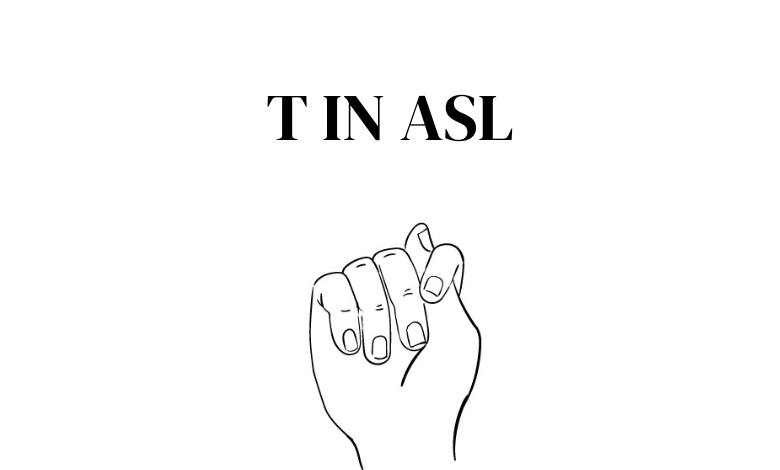How to Sign the Letter T in ASL: Step-by-Step Guide & Practice

If you’re learning American Sign Language (ASL), one of the first things you’ll meet is the manual alphabet — the set of handshapes representing letters A through Z. You’ll use it to fingerspell names, technical terms, or words without a standard ASL sign. Among those letters, “T” is one you’ll often need. A clear, correct T helps others read your fingerspelling fluently.
In this article, I’ll walk you through how to sign the letter T in ASL, explain common mistakes, and suggest practice drills. I’ll also share tips I’ve learned (and mistakes I made) so you can avoid frustration. By the end, you’ll be confident using T in your fingerspelling and know how to improve.
2. Basics: What Is Fingerspelling in ASL?
Before focusing on T, it helps to understand fingerspelling as a system.
-
Fingerspelling means spelling words using handshapes that correspond to letters. In ASL, we use a manual alphabet.
-
It’s used for proper names, technical terms, brands, or words that don’t have a dedicated ASL sign.
-
The ASL manual alphabet has 22 distinct handshapes, though they map to 26 English letters. Some shapes are reused.
-
When fingerspelling, you typically hold your palm facing somewhat outward (10 o’clock orientation), not straight toward yourself. That makes the letters easier to see for the person you’re signing to.
-
Speed and clarity matter. At first, you sign slowly and carefully; later, you blend it more naturally.
Because fingerspelling is so foundational, mastering each letter clearly—including T—will help you read others’ fingerspelling and have your own be readable.
Read Also: The Ultimate Guide to Eagles T Shirts — How to Choose, Care, and Style Them
3. How to Sign the Letter “T”
Let’s get to T itself.
3.1 Step-by-Step Instructions
-
Choose your dominant hand (the hand you write with or are more comfortable using) for fingerspelling.
-
Make a fist, curling in all four fingers (index, middle, ring, pinkie) toward your palm.
-
Tuck your thumb between your index finger and middle finger, so it protrudes a bit from between them.
-
The fist faces outward (i.e. toward your conversation partner) so they can see the thumb placed between.
So in short: “fist, thumb between index & middle” is the T handshape in ASL.
Handspeak describes it: “dominant fist with the thumb protruding through the web between forefinger (index) and middle finger.”
Another resource says the same: “make a fist with your dominant hand, palm facing out, and place your thumb between your index and middle fingers.”
3.2 Thumb Position & Hand Orientation
-
The thumb must be squeezed in just a bit—not fully hidden, not overly sticking out.
-
The space between index and middle is where the thumb sits.
-
The palm should face outward (toward the person you’re signing to), or at a slight angle so your wrist isn’t strained.
-
Be careful not to have your wrist twisted or your fingers loose: the shape must be firm.
If someone watches you sign T, they should see, from their view, a fist and the thumb showing between those two fingers. That visual cue is what distinguishes T from other letters.
To further help, here’s how other sources describe it: “palm facing outward, thumb tucked between index and middle fingers.”
Also, Handspeak mentions the orientation and “protruding through the web.”
So thumbs up (pun intended) — you want the thumb visible in that space.
3.3 Visual & Memory Tips
-
Imagine the thumb is peeking between two fingers—like a head popping between fingers.
-
Think: “fist, but with a secret thumb hiding in between index and middle.”
-
If your thumb is out too far, the shape becomes ambiguous or mistaken for other letters (or just looks messy).
-
Watch video demos. For example, ASL Bloom or HandSpeak or YouTube tutorials show exactly how it looks.
4. Common Mistakes & How to Avoid Them
Even with simple letters, learners (myself included) make mistakes. Here’s what to watch out for, and how to correct them.
4.1 Mistake: Thumb is not tucked or is hidden
If the thumb is not between index and middle, or is tucked too much so it’s not visible, others may misread the T. Sometimes people mistakenly tuck the thumb behind the fingers entirely or keep it on the side. That’s wrong.
4.2 Mistake: Loose fist or fingers curled unevenly
If your fist is loose, fingers not fully curled, it may look like another letter—or just look sloppy. Make sure your fingers press in and form a solid shape.
4.3 Mistake: Palm orientation wrong (facing sideways or yours)
If your palm is facing inward (toward yourself) or too much sideways, the letter is harder to read. Orient it outward or slightly angled so the viewer can see.
4.4 Mistake: Overly exaggerated thumb position
Thumb sticking out too far or at odd angles makes it confusing. Keep it neat, just between the fingers.
4.5 Mistake: Too fast too soon
Beginners tend to rush. When you rush, your T can break shape or lose clarity. Slow down initially, focus on accuracy, then gradually speed up.
4.6 Insights from Deaf / ASL users
In a Reddit thread about signs including T, someone noted:
“Unless the T changed in the past 50 years, I doubt it. The thumb should still be tucked, though.” Reddit
That reflects what many native or fluent signers say: the thumb position is key and should remain tucked.
Sometimes variations exist, but the base rule holds: the thumb must be between index and middle.
From practice, I once signed T too loosely when learning, and a Deaf peer asked me: “Is that T or something else?” That drove home the importance of crispness.
5. Practice Exercises for T and Other Letters
Knowing the shape is one thing; being able to use it fluidly is another. Here are drills and routines I’ve used or seen others use.
5.1 Repetition & slow practice
-
Sign T slowly, watch your hand in a mirror, compare with reference images.
-
Hold the shape for a few seconds each time, then release, then repeat.
-
Do this 10–20 times per session.
5.2 Spelling simple words with T
Pick simple words containing T and practice spelling them: e.g.:
-
“Tom” (T-O-M)
-
“Cat” (C-A-T)
-
“Tea” (T-E-A)
-
“Start” (S-T-A-R-T)
Spell them slowly, focusing on each letter. Over time, pick longer words.
5.3 Speed drills (when comfortable)
Once you’re confident, gradually speed up:
-
Use a timer, aim to spell 5 words in 30 seconds.
-
Spell names of family members or friends with T inside.
-
Use flashcards of letters and spell out sequences.
But always ensure clarity before speed.
5.4 Finger gym / warmups
To keep hands limber:
-
Stretch fingers gently before sessions.
-
Make a relaxed fist, release, repeat.
-
Rotate wrist a little, get flexibility.
These warmups reduce stiffness and improve hand shape control.
5.5 Practice with partner or mirror
-
Use a mirror to self-check your shape.
-
Ask someone to watch or read your fingerspelling.
-
Join a signing group: get feedback from fluent signers.
When I started, I’d practice spelling my name into a mirror. Sometimes I thought I saw T, but the thumb was off. Mirror feedback saved many mistakes.
6. Variations & Comparison
When learning T in ASL, you may wonder: do other sign languages use the same shape? Are there variations? Should you worry?
6.1 Different sign languages, different alphabets
-
ASL is particular to American Sign Language. Other sign languages (British, French, etc.) have their own alphabets or manual signs.
-
Some manual alphabets borrow from the ASL shapes; others differ.
For example, the French manual alphabet has T as well, but its thumb position differs slightly.
6.2 Regional or stylistic variants
Within ASL, there may be slight differences depending on signer preferences or style (dominant hand use, hand size). But the core shape remains.
Some older or historical versions might show slight deviations. But for clarity, stick with the standard “fist + thumb between index/middle” form.
6.3 When variation is acceptable (or not)
If you’re among Deaf or fluent signers, slight variation (in angle or wrist tilt) is okay as long as others can read you. But major deviations (thumb elsewhere, loose grip) reduce intelligibility.
So in early learning, aim for the standard form. As you gain fluency, minor flex is fine.
7. Tools & Resources You Can Use
To reinforce your learning, you’ll benefit from external aids. Here are some tools I liked.
7.1 Video tutorials & YouTube
Watching the movement helps. Search “How to sign T in ASL” or “ASL fingerspelling T tutorial.” Many ASL educators post step-by-step demos.
7.2 Online dictionaries & sites
-
HandSpeak has clear descriptions of each letter shape.
-
ASL Bloom has signs and tutorials (for example, the T sign).
-
LifePrint (ASL 101) is a good resource for fingerspelling background.
7.3 Mobile / web apps
There are apps for ASL alphabet practice. Some allow you to trace handshapes, test recognition, or record yourself. Use them daily.
7.4 Charts & flashcards
Print or download an ASL alphabet chart. Keep it nearby so you glance at it often (on your wall, your phone).
Use flashcards (paper or digital) with letter on one side, handshape on the other. Practice randomly.
7.5 Community & Deaf creators
Follow Deaf signers and ASL educators on social media (YouTube, Instagram, TikTok). Watching native signers helps train your eye and rhythm.
I learned a lot from watching Deaf creators — their fluidity, slight variations, and transitions between letters. Those subtleties don’t show up in static images but matter when you fingerspell fast.
8. Real-Life Use & Tips
Here are some practical tips and real-world things to watch for.
8.1 How often will you use “T”?
Because T is common (in names & words), you’ll hit it frequently. For example, names like “Tom,” “Tina,” “Taylor,” “Pat,” “Matt.” Also words like “test,” “type,” “start.”
So mastering T early gives you confidence in many words.
8.2 Transitions & fluidity
In real conversation, fingerspelling often flows. You don’t always pause fully between letters. Transitions between letters (from T to the next letter) need smoothness. That means your hand must reset quickly after T to the next handshape.
For example, after signing T, your fingers might need to open or change shape for the next letter (say, “E”). Practice transitions (T → E, T → S, etc).
8.3 Mistakes in conversation
Sometimes people misinterpret your T if your thumb is off or your speed is too fast. If someone looks confused, slow down and re-spell. Better to be understood than fast.
Also, if someone uses a different orientation or slight variation that you don’t recognize, ask or clarify.
8.4 Personal reflection
When I first learned ASL, I struggled with thumb positioning for T. My thumb would hide behind or push outward awkwardly. People would ask, “Was that T or something else?” It taught me to slow, check shape, and ask for feedback.
Later, when I watched fluent signers at Deaf events, I saw how natural their T looked—even at fast speed. That motivated me to get clarity first, then speed.
That’s my advice: aim for clarity first. Once clarity is reliable, you can speed up.
9. Conclusion & Next Steps
You now have a comprehensive guide to signing the letter T in ASL: how to form it, common mistakes, practice drills, variations, and resources. Remember, the thumb must be between index and middle, your fist solid, your palm oriented for readability, and your motion consistent.
Master T before rushing on. Use mirrors, apps, Deaf community feedback, and repeated practice. As you become comfortable, integrate T into names and words, then practice smooth transitions.
Once you feel confident with T, move on to other letters. Keep a daily practice habit — even 5 minutes a day helps. Over time, your fingerspelling will become natural, clear, and fluid.
Believe in your progress. Learning ASL is a journey — making mistakes is part of it. But clarity, patience, and consistent effort will get you there.
FAQ (Frequently Asked Questions)
Q1: Can I use any hand other than my dominant hand to sign T?
A: You can, but it’s typical to use your dominant hand (the hand you write with). Using a non-dominant hand may slow your speed or reduce clarity.
Q2: My thumb is too short/small — can I still do T?
A: Yes. Even if the thumb is small, you can tuck it slightly and make sure it protrudes just a bit. The key is visible positioning, not how far it sticks.
Q3: Is there a different T shape in British or other sign languages?
A: Yes. Different sign languages use different manual alphabets. Their T may differ in thumb placement or orientation. ASL’s T is specific to American Sign Language.
Q4: How fast should I practice fingerspelling T?
A: Start slow and accurate. Once you can do it clearly, gradually increase speed. Accuracy always comes before speed.
Q5: I signed T but others misread it. What should I do?
A: Slow down, reset your hand, and re-sign it. Ask for feedback. Ensure your thumb is between index & middle, your fist is tight, and palm orientation is correct.



